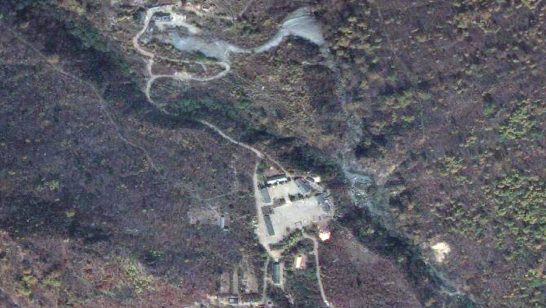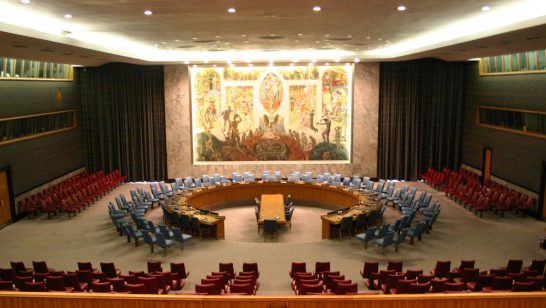
Director of the US Defense Intelligence Agency Lt. Gen. Robert P. Ashley, Jr. and Senior Director at the National Security Council Tim Morrison claimed yesterday that Russia is likely undermining the Comprehensive Nuclear-Test-Ban Treaty (CTBT) by conducting low-yield tests at the Novaya Zemlya test site, an archipelago in the Arctic Ocean. However, no evidence to support these claims has been made public, neither through an actual compliance determination from the US government nor the Preparatory Commission that backs the CTBT and monitors Novaya Zemlya, as well as the entire planet for that matter, around-the-clock for nuclear tests.
The technical divisions of the Preparatory Commission maintain that nothing unusual has been detected. While the organization has the proven ability to detect low-yield tests even less than a kiloton in size, especially at known test sites from which there is much more data to compare, the system is not completely infallible and the type of supercritical testing that Ashley and Morrison may be pointing to could possibly go unnoticed. Luckily, it is highly unlikely that Russia is conducting such testing as there would not be much military significance and pathways do exist for finding out answers: mutual transparency exchanges guaranteed under the CTBT, which needs to enter-into-force for the international community to fully enjoy additional benefits.
Ashley, who claims that Russia needs to conduct such tests to improve its nuclear weapons, echoed a point that the limited pro-testing community in the United States has also argued for its own long-standing and future arsenals. In turn, Ashley’s conjectures say more about current thinking amongst decision-makers in the United States than it does about Russia, a country that ratified the CTBT almost two decades ago and regularly partakes in the international campaign for the Treaty’s final entry-into-force. These potentially unfounded claims may exemplify the dangerous fetishization of testing as a necessary evil, despite clearly written technical assessments that nuclear testing is not necessary to maintain American (or Russian) nuclear arsenals and that the US will suffer zero national security repercussions from joining Russia and ratifying the CTBT. The movement towards reigniting testing also ignores long-standing evidence of substantial adverse humanitarian and environmental consequences which remind us of why global nuclear disarmament is a goal we must all strive for.
Although supercritical testing of a low yield would not elicit the same effects as the wide range of testing of the previous century, it would still violate the CTBT and erode the norm against testing. It is worrisome that key members of the military and security establishment may be joining the President’s National Security Advisor John Bolton’s search for even an ounce of evidence to renege from additional non-proliferation commitments, and it is true that rumours have been circulating that Bolton has been advising President Donald Trump to “unsign“ the CTBT. In a worst-case scenario, these individuals may be building a case for the possible resumption of testing. Thus, we must ask ourselves: is the nuclear-test-ban the next US arms control target? If so, what will we do to educate the US public about the Treaty’s merits before it is too late?
Almost 25 years ago, the United States helped finish leading a four-decade process to put an end to a haunting era of nuclear testing, to which the US contributed about half of over 2000 known nuclear tests. Previously, a Partial-Test-Ban Treaty (PTBT) had left the door to testing open by allowing for underground tests. However, with a great deal of pressure from civil society across the globe, the new, comprehensive agreement banned any testing, anywhere. The final text was seen as a major diplomatic achievement, as many nuclear states wanted the opportunity to conduct at least limited testing to sustain the reliability of their weapons. Eventually, this idea was abandoned, and the resulting Treaty adopted a zero threshold, which is far easier to monitor than varying levels, and countries had to innovate new ways to ensure the safety of their nuclear weapons.
To verify the zero threshold, an intricate blueprint for the CTBT’s International Monitoring System (IMS) was written that would use an array of sensors to locate any man-made anomalies that might be nuclear tests. In addition, the CTBT also built out the procedures for a robust on-site inspection process that would allow for fact-finding missions on the ground in the case of any anomalies. Such anomalies would need to be voted upon by member states after their own technical assessments to determine if they were serious enough for resources to be expended on an inspection. This provision will only come into effect when the United States and seven other remaining nuclear-technology holding countries ratify the CTBT. As gigabytes of raw data pour into the Vienna-based Preparatory Commission at this very moment and every second of every day, the IMS has proven to have far more benefits than originally imagined, as it also gives a great deal of information on the planet’s health to scientists across the world in a variety of fields. Thus, a democratic, transparent, and science-backed approach has continued to define the CTBT as a distinctive tool for global peace and security, sustainable development, and risk reduction.
At the time the CTBT opened for signature, many countries ratified the Treaty after undergoing domestic legal processes that often required the approval of Treaty by legislators. Although the first to sign, the United States regrettably did not end up ratifying the Treaty the single time it has ever been put before the US Senate in 1999. The reason was that some were sceptical of the Treaty’s verification system and its efficacy at catching cheaters, falling yet again into the US proclivity to sign but not ratify international agreements, even if it had a strong voice in the negotiation process. Despite the US providing a good portion of the billion dollars invested over the past two decades into the Treaty’s verification regime—which has reached over ninety-percent completion—not a single hearing has been held by the Senate on the CTBT since 1999. Many had hoped that US President Barack Obama’s pledge to see the CTBT through would cause a chain reaction amongst some of the remaining other seven countries needed for the Treaty to enter-into-force, but such efforts never manifested even in much of an educational campaign geared towards Congress.
Surprising to many, Russia has already ratified the CTBT. Although Russia, in addition to all other nuclear-armed states, is undertaking modernization plans for its nuclear arsenal, it has no stated interest in resuming nuclear tests and pledges at any opportunity to fight for the CTBT until it is universally adopted. On the other hand, the Trump administration has dangerously shortened the United States’s testing readiness time and increased the rate of and funding for subcritical experiments that could grow into a size that violates the CTBT, whilst also unequivocally stating that it will not pursue CTBT ratification despite its signature and continued financial investments in the IMS. To many countries, such rhetoric is not only in contravention of the letter and spirit of the CTBT but also the Nuclear Non-Proliferation Treaty (NPT) which will undergo its next review in 2020.
The fear the nuclear expert community and civil society groups have is that this is another iteration of the Trump administration’s approach to arms control in general, with eerie echoes of the ways it has left both the Joint Comprehensive Plan of Action (JCPOA), or Iran nuclear deal, and the Intermediate-Range Nuclear Forces Treaty (INF). However, in this case, the CTBT is not a bilateral or limited multilateral agreement but a fundamental, global pillar to the entire non-proliferation regime. A US exit from the CTBT would be like running into a monsoon with a newspaper over our heads: foolish from the start. It would directly undermine US national security, as it would empower pro-testing factions in the US to set a new precedent for other countries across the world, making nuclear proliferation easier.
The statements being made by US officials may also indirectly put the Preparatory Commission’s technical credibility into question to those who do not know the nuances of different types of testing. Those using this situation to undermine the organization’s verification capabilities must remember that the IMS detection threshold is quite remarkable and much lower than what was originally imagined possible. In fact, the US continues to put a great deal of funding into the IMS on a yearly basis because of its proven reliability. The Preparatory Commission knows what type of signals to look for from previous non-nuclear and nuclear explosions. There are very objective methods to analyze this data, and paired with the frequency of what naturally occurs, especially at known test sites like Novaya Zemlya, cross-correlation methods can be used to pinpoint even low-yield tests. Alas, the system is not completely infallible as tiny, rather technically inconsequential, tests could go unnoticed, but that is why the Treaty provides for mutual confidence-building measures separate from on-site inspections that could be used even now. It is important that facts lead the debate on compliance because what has often been a lack of transparency on subcritical testing, which is allowed under the Treaty, has added to suspicions of explosive low-yield and hydronuclear testing that would violate the CTBT.
Stretching weak intelligence claims and then circumventing the built-in mechanisms to check compliance through transparency exchanges and on-site inspections is not acceptable US leadership on non-proliferation. This is especially true since US officials have mistaken natural events at Novaya Zemlya as nuclear tests in the past, highlighting the need for a supplemental agreement of some kind that would calm anxieties on both sides. As it has been reported that Ashley and Morrion’s comments do not represent consensus amongst the US intelligence community, further information should be shared on these allegations even if a strict compliance determination cannot be made. In addition, similar to their statements on the re-joining the JCPOA, US presidential candidates should state their intention to push for CTBT ratification when entering office and interest in working with Russia on areas of concern outside the Treaty parameters.
In the spirit of the CTBT, Russia must also showcase strategic restraint and leave the door open for mutual confidence-building measures such as the aforesaid transparency exchanges, even if it is unlikely for the current US administration to take them up on the offer like in the case of the INF. More importantly, Russia and the other 167 ratifying countries should take this message as a cue that without pushing for action from the United States, China, and other nuclear-armed countries such as Israel, India, Pakistan, and North Korea, to ratify the CTBT, the norm against nuclear testing may slowly erode. This could especially be the case with new delivery means in the pipeline such as hypersonics, which, if a country wanted to use to deliver nuclear weapons, they would probably need to test.
Alas, this is a cynical view at a time that the entire world is abiding by at least a global moratorium on nuclear testing with North Korea’s stated freeze last year. It is also a cynical view at a time that the CTBT’s verification regime has neared completion and proven, namely in the case of North Korea, that even low-yield tests less than a kiloton can be accurately detected and located. However, as seen in the cases of the collapse of other arms control agreements since President Trump took office, anything is possible and we should act accordingly.
The opinions articulated above also do not necessarily reflect the position of the European Leadership Network or any of its members. The ELN’s aim is to encourage debates that will help develop Europe’s capacity to address pressing foreign, defence, and security challenge.



